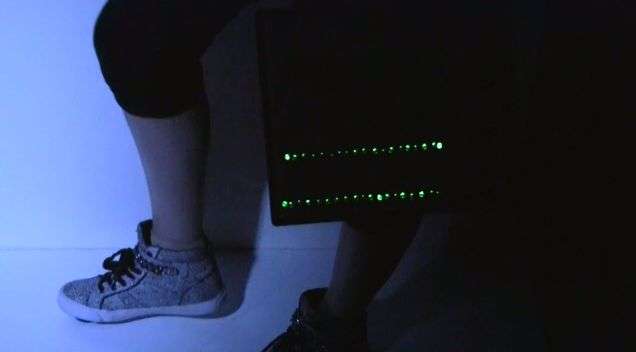June 20, 2016 report
New 'shape-adaptive' device turns body motion into power source (w/ videos)

(Tech Xplore)—A combined team of researchers with members from several institutions in China and the Georgia Institute of Technology, has developed a flexible nanogenerator that harnesses the energy from moving body parts and uses it to run electronic devices. In their paper published in the journal Science Advances, the team describes their new device, how they made it bendable, and the ways they believe it might be used.
The first triboelectric nanogenerator (TENG) was developed at Georgian Tech back in 2012, and since that time teams across the world have been hard at work attempting to create consumer devices that will be both useful and inexpensive. If a team succeeds, we might soon seen devices that are affixed to our skin or clothes, powered by nothing more than our movements. Such devices work by using the normal motion of the human body, such as a foot tapping, to cause two different types of material in the device to rub together, or more recently, when they are pressed together, so as to prevent erosion of material. Up till now, most such devices have been rigid. In this new effort, the researchers claim they have developed a flexible TENG that is also stretchable.
To make the new device, the team combined a liquid electrode with a rubber cover—they suggest the result is actually a new type of device, one they are calling Shape Adapting TENG (saTENG). They report that sample devices have been stretched up to 300% without any loss in performance. A device they built was used to capture the energy of a person sitting down and tapping their foot on the ground—it was enough to run 80 LED lights. To prove its adaptability, they also fashioned a device into a bracelet and harnessed enough power from simple arm movements to power another set of LEDs. They report both devices were very inexpensive to make—approximately 50 cents.
The team notes also that by using water as the material for the electrode, they have opened up a new area of research, because the water itself is moved due to the external motion, allowing for another source of mechanical energy that can be harvested. The team plans to next study the possibility of increasing power output by perhaps stringing multiple devices together and of using their technology as the basis for medical sensing devices or even prosthetics.
More information: F. Yi et al. A highly shape-adaptive, stretchable design based on conductive liquid for energy harvesting and self-powered biomechanical monitoring, Science Advances (2016). DOI: 10.1126/sciadv.1501624
Abstract
The rapid growth of deformable and stretchable electronics calls for a deformable and stretchable power source. We report a scalable approach for energy harvesters and self-powered sensors that can be highly deformable and stretchable. With conductive liquid contained in a polymer cover, a shape-adaptive triboelectric nanogenerator (saTENG) unit can effectively harvest energy in various working modes. The saTENG can maintain its performance under a strain of as large as 300%. The saTENG is so flexible that it can be conformed to any three-dimensional and curvilinear surface. We demonstrate applications of the saTENG as a wearable power source and self-powered sensor to monitor biomechanical motion. A bracelet-like saTENG worn on the wrist can light up more than 80 light-emitting diodes. Owing to the highly scalable manufacturing process, the saTENG can be easily applied for large-area energy harvesting. In addition, the saTENG can be extended to extract energy from mechanical motion using flowing water as the electrode. This approach provides a new prospect for deformable and stretchable power sources, as well as self-powered sensors, and has potential applications in various areas such as robotics, biomechanics, physiology, kinesiology, and entertainment.
© 2016 Tech Xplore




















